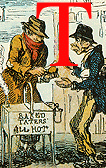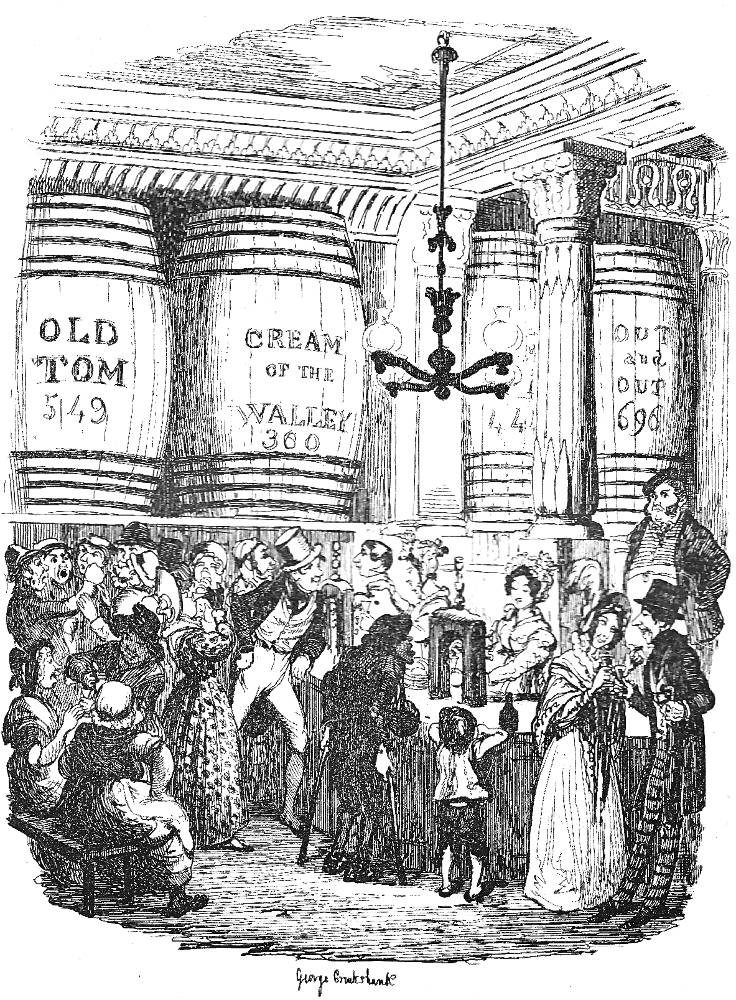Dickens’s sketch of a typical London street scene, initially published in the Evening Chronicle on 7 February 1835, is dedicated to "Gin-Shops," of which the metropolis appears to have possessed an abundance in the early 1830s, catering chiefly to the lower classes. Both the article and the subsequent Cruikshank illustration reference (at least, by implication) Gin Lane (1751) by William Hogarth. — Philip V. Allingham
Dickens describes a gin shop in Sketches by Boz
 he extensive scale on which these places are established, and the
ostentatious manner in which the business of even the smallest among them is divided into
branches, is amusing. A handsome plate of ground glass in one door directs you "To the
Counting-house;" another to the "Bottle Department;" a third to the "Wholesale
Department;" a fourth to "The Wine Promenade;" and so forth, until we are in daily
expectation of meeting with a "Brandy Bell," or a "Whiskey Entrance." Then, ingenuity is
exhausted in devising attractive titles for the different descriptions of gin; and the
dram-drinking portion of the community as they gaze upon the gigantic black and white
announcements, which are only to be equalled in size by the figures beneath them, are
left in a state of pleasing hesitation between "The Cream of the Valley," "The Out and
Out," "The No Mistake," "The Good for Mixing," "The real Knock-me-down," "The
celebrated Butter Gin," "The regular Flare-up," and a dozen other, equally inviting and
wholesome liqueurs. Although places of this description are to be met with in
every second street, they are invariably numerous and splendid in precise proportion to
the dirt and poverty of the surrounding neighbourhood. The gin-shops in and near Drury
Lane, Holborn, St. Giles's, Covent Garden, and Clare Market ar the handsomest in London.
There is more of filth and squalid misery near those great thoroughfares than in any part
of this mighty city.
he extensive scale on which these places are established, and the
ostentatious manner in which the business of even the smallest among them is divided into
branches, is amusing. A handsome plate of ground glass in one door directs you "To the
Counting-house;" another to the "Bottle Department;" a third to the "Wholesale
Department;" a fourth to "The Wine Promenade;" and so forth, until we are in daily
expectation of meeting with a "Brandy Bell," or a "Whiskey Entrance." Then, ingenuity is
exhausted in devising attractive titles for the different descriptions of gin; and the
dram-drinking portion of the community as they gaze upon the gigantic black and white
announcements, which are only to be equalled in size by the figures beneath them, are
left in a state of pleasing hesitation between "The Cream of the Valley," "The Out and
Out," "The No Mistake," "The Good for Mixing," "The real Knock-me-down," "The
celebrated Butter Gin," "The regular Flare-up," and a dozen other, equally inviting and
wholesome liqueurs. Although places of this description are to be met with in
every second street, they are invariably numerous and splendid in precise proportion to
the dirt and poverty of the surrounding neighbourhood. The gin-shops in and near Drury
Lane, Holborn, St. Giles's, Covent Garden, and Clare Market ar the handsomest in London.
There is more of filth and squalid misery near those great thoroughfares than in any part
of this mighty city.


Left: The Gin-Shop. George Cruikshank. 1839. This is the illustration that originally accompanied Dickens's description of a gin shop and its meretricious glitter. Right: Gin Lane. William Hogarth. 1751. Taken together the two images serve as representations of before and after gin affects Londoners. [Click on images to enlarge them.]
We will endeavour to sketch the bar of a large gin-shop, and its ordinary customers, for the edification of such of our readers as may not have had opportunities of observing such scenes; and on the chance of finding one well suited to our purpose, we will make for Drury-Lane, through the narrow streets and dirty courts which divide it from Oxford-street, and that classical spot adjoining the brewery at the bottom of Tottenham-court-road, best known to the initiated as the "Rookery." . . . .
You turn the corner. What a change! All is light and brilliancy. The hum of many voices issues from that splendid gin-shop which forms the commencement of the two streets opposite; and the gay building with the fantastically ornamented parapet, the illuminated clock, the plate-glass windows surrounded by stucco rosettes, and its profusion of gas-lights in richly-gilt burners, is perfectly dazzling when contrasted with the darkness and dirt we have just left. The interior is even gayer than the exterior. A bar of French-polished mahogany, elegantly carved, extends the whole width of the place; and there are two side-aisles of great casks, painted green and gold, enclosed within a light brass rail, and bearing such inscriptions, as "Old Tom, 549;" "Young Tom, 360;" "Samson, 1421" — the figures agreeing, we presume, with "gallons," understood. Beyond the bar is a lofty and spacious saloon, full of the same enticing vessels, with a gallery running round it, equally well furnished. On the counter, in addition to the usual spirit apparatus, are two or three little baskets of cakes and biscuits, which are carefully secured at top with wicker-work, to prevent their contents being unlawfully abstracted. Behind it, are two showily-dressed damsels with large necklaces, dispensing the spirits and "compounds." They are assisted by the ostensible proprietor of the concern, a stout, coarse fellow in a fur cap, put on very much on one side to give him a knowing air, and to display his sandy whiskers to the best advantage.
The two old washerwomen, who are seated on the little bench to the left of the bar, are rather overcome by the head-dresses and haughty demeanour of the young ladies who officiate. They receive their half-quartern of gin and peppermint, with considerable deference, prefacing a request for "one of them soft biscuits," with a "Jist be good enough, ma’am." They are quite astonished at the impudent air of the young fellow in a brown coat and bright buttons, who, ushering in his two companions, and walking up to the bar in as careless a manner as if he had been used to green and gold ornaments all his life, winks at one of the young ladies with singular coolness, and calls for a "kervorten and a three-out-glass," just as if the place were his own. "Gin for you, sir?" says the young lady when she has drawn it: carefully looking every way but the right one, to show that the wink had no effect upon her. "For me, Mary, my dear," replies the gentleman in brown. "My name an’t Mary as it happens," says the young girl, rather relaxing as she delivers the change. "Well, if it an't, it ought to be," responds the irresistible one; "all the Marys as ever I see, was handsome gals." Here the young lady, not precisely remembering how blushes are managed in such cases, abruptly ends the flirtation by addressing the female in the faded feathers who has just entered, and who, after stating explicitly, to prevent any subsequent misunderstanding, that "this gentleman pays," calls for "a glass of port wine and a bit of sugar." — "Scenes," Chapter 22, "Gin-Shops," p. 135-137.

The Gin Shop. Fred Barnard. 1876 Wood-engraving . [Click on the image to enlarge it.]
Related Material
- Alcohol and Alcoholism in Victorian England (sitemap)
- “Great is thy power, O Gin” — G. W. M. Reynolds on the harm it does to the poor
- Slums and Slumming in Late-Victorian London
Bibliography
Cohen, Jane Rabb. Part One, "Dickens and His Early Illustrators: 1. George Cruikshank. Charles Dickens and His Original Illustrators. Columbus: Ohio University Press, 1980. Pp. 15-38.
Dickens, Charles. "Scenes," Chapter 22, "Gin-Shops." Sketches by Boz. Illustrated by George Cruikshank. London: Chapman and Hall, 1839; rpt. 1890. Pp. 134-138.
Dickens, Charles. "Scenes," Chapter 22, "Gin-Shops." Sketches by Boz. Illustrated by Fred Barnard. The Household Edition. London: Chapman and Hall, 1876. Pp. 85-88.
Dickens, Charles. "Scenes," Chapter 22, "Gin-Shops." Sketches by Boz. Illustrated by Harry Furniss. The Charles Dickens Library Edition. London: Educational Book Company, 1910. Vol. 1. Pp. 172-177.
Last modified 11 May 2017